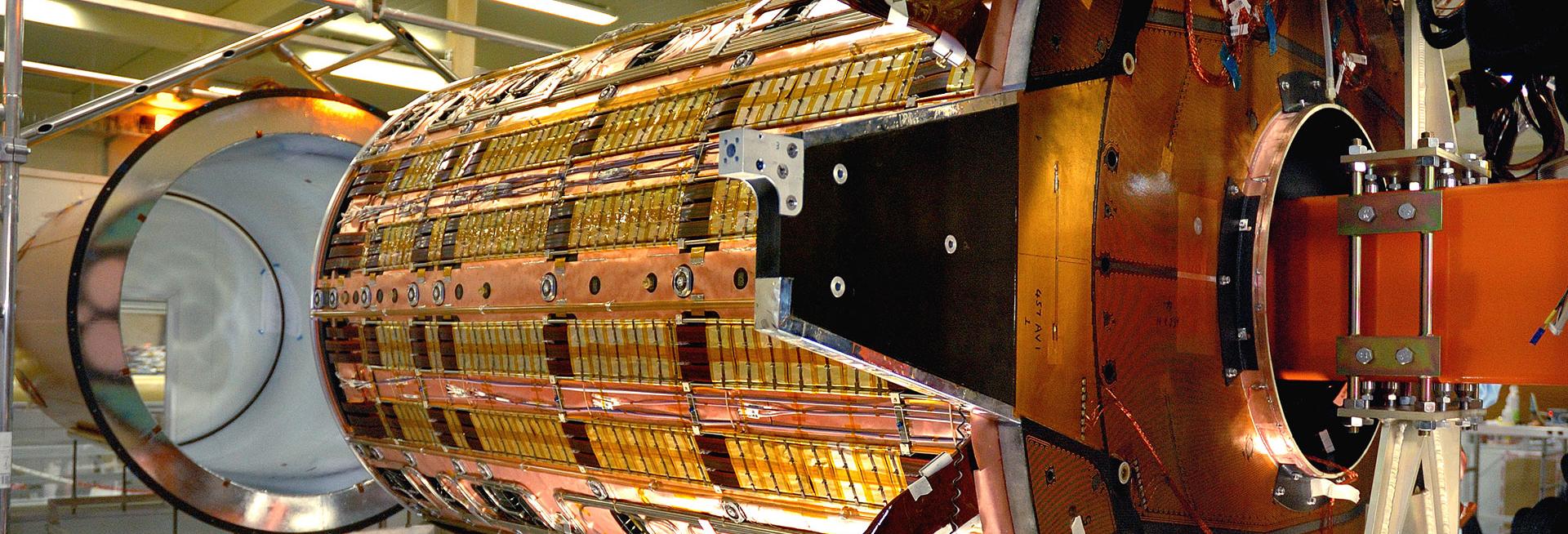The Large Hadron Collider is one of the highest profile scientific projects of our time, with the discovery of the Higgs boson in 2012 being the scientific highlight to date. Our key role in the ATLAS collaboration and its search for the Higgs boson led to the development of the citizen science project Higgs Hunters.
This two-stage project involved searches for new particles by citizen scientists, and subsequent analysis by UK school students. The citizen science project reached 42,280 participants from over 170 countries.
The research
Particle collisions are observed in the LHC using large complex detectors, the largest of which is the ATLAS experiment. Major components of the ATLAS tracking detector were constructed in Oxford, and Oxford scientists have been at the heart of the commissioning, operation, analysis and interpretation of the data from that experiment. The research at Oxford is funded by STFC (the Science and Technology Research Council).
Most particles decay a tiny fraction of a second after their creation. The particles are detected by the ATLAS experiment and reconstructed (interpreting the electronic signals produced by the detector) and compared with predictions, using sophisticated algorithms. However, there is a speculative theory that suggests that sometimes the Higgs boson might decay to a new particle, which would travel macroscopic distances before decaying, and that these reconstructions could be done with the help of citizen science volunteers.
People-powered research
Our model was based on a partnership with The Zooniverse platform, which has found that when many non-experts classify the same image, on average the wisdom of the crowd wins out. Groups of people have previously been shown to beat computer algorithms, and they are also capable of spotting unusual objects in images – unlike computers – for example, unexpected galaxy features. The Higgs Hunters project (higgshunters.org), in collaboration with Zooniverse, uses a similar citizen science classification model.
Some 42,280 participants from over 179 countries classified 1,500,000 interesting features on 39,000 distinct images. This puts Higgs Hunters in the top 2% of projects by number of participants across the entire Zooniverse (which itself is the world’s biggest citizen science platform). Most participants classified a handful of images, with 1,000 classifying over 100, 100 classifying over 1,000, and one individual classifying over 25,000.
More than 80% of survey respondents reported improved physics knowledge having taken part in the project, 87% reported having gone on to read or watch more about science and 47% were more likely to go on to study physics. An analysis was also performed on the 20,257 comments from 1,345 users on the Higgs Hunters 'talk' forum; the citizen scientists had formed a community with their own technical language and experts, with increased use of advanced technical language, demonstrating deep engagement with the science.
Young researchers
Higgs Hunters on the Zooniverse platform was followed with a schools phase of the project launched in 2016, run in partnership with IRIS (the Institute of Research in Schools). This allowed Key Stage 4 and 5 students the opportunity to analyse the effectiveness of the citizen scientists’ classification and to choose an aspect to investigate for themselves.
In total, 105 schools downloaded the data from IRIS and 45 schools accessed the supporting resources. An explanatory webinar aimed at teachers (who watched from 28 schools) and a video covering the launch event have a combined viewing of over 500 views on YouTube.
Of all the schools that took part in the project, 70% were in the state sector. Despite the challenging nature of the project, 51 pupils from 19 schools showed sustained engagement throughout the process. Selected student researchers (20) were invited to submit their results as posters to present at a two-day Higgs Hunters conference, held in the Department of Physics in Oxford. The students then wrote up their work, producing conference proceedings that were internally reviewed by the ATLAS collaboration at CERN. This was the first of their kind to be accepted as an ATLAS Notes publication.
The students, who were interviewed by phone after the conference, stated that the opportunity to conduct original research had: increased their physics subject knowledge; helped inform/confirm future choices of study; increased awareness and enjoyment of research; increased understanding of the difference between school physics and research physics; developed a wide range of practical and presentation skills; and developed their confidence and resilience.
'The whole process has given the students the confidence to talk about Physics beyond the textbook. And for me, as a teacher, it’s meant that I’ve got back in touch with real research and what’s going on. It’s been inspirational.'
Physics teacher, Camden School for Girls

